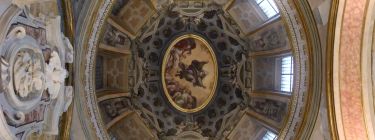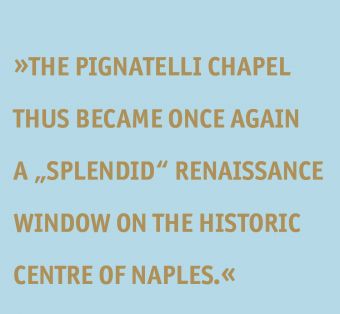
The New Relevance of Heritage
Professor of Sociology of Law since 1986, is Rector of the Suor Orsola Benincasa University of Naples, Vice President of the CNR (National Research Council)

Renaissance 1.0
Case study: The Pignatelli Chapel, Naples: How bringing past Renaissance alive with digital tech opens new civic and economic spaces
The chapel or small family church of Santa Maria dei Pignatelli, located in the heart of Naples, in Piazzetta Nilo, has 14th-century origins and was first renovated from as early as the last decades of the 15th century at the behest of Ettore Pignatelli, Duke of Monteleone and Borrello and future viceroy of Sicily. The works lasted until 1515 and included the construction of the two important funerary complexes that make the chapel one of the jewels of Neapolitan art of the mature Renaissance: the tomb of Carlo Pignatelli, on the left wall, the work of Tommaso Malvito’s workshop around 1506-07; and the small chapel of Caterina Pignatelli, the work of the great Spanish sculptor Diego de Silóe around 1513-14, rich in decorations taken from Antiquity and close to the culture of the Papal Rome of Raphael, Michelangelo and Sansovino. From 1736 the chapel was restored and assumed baroque forms. It was provided with a new altar in polychrome marble designed by Gaetano Buonocore and realised by Gennaro Di Martino, with rich marble decorations on the walls; a floor in inlaid marble was also added, realised by the same Di Martino and by Antonio Di Lucca on a drawing by Ferdinando Fuga (1761). A bowl-shaped dome was frescoed in 1772—as well as the drum, pendentives and sails of the adjacent vault—by Fedele Fischetti.
This phase was soon followed by a long period in which this extraordinary Renaissance masterpiece was neglected and fell into a state of abandonment, neglect and ruin. In the 1990s, the Pignatelli family decided to donate the chapel to the Suor Orsola Benincasa University which immediately carried out a vast program of works that, between 1999 and 2007, provided for the restoration of the structure and the arrangement of the annexed rooms. Then, from 2013 to 2015, the works of art preserved in the chapel were restored through the Great Project for the Historic Center of Naples, enhancement of the UNESCO World Heritage site. Finally, between 2016 and 2017, important sculptures by Diego de Silóe pertaining to the chapel of Caterina Pignatelli were brought back and relocated on new supports in the original site which had been devastated by thefts in the 1970s.
The Pignatelli Chapel thus became once again a „splendid“ Renaissance window on the historic centre of Naples.

Renaissance 2.0
But the above is only the first stage of an important process of recovery and enhancement of this masterpiece. In recent years, with a project that was completed in 2020, the University Suor Orsola has designed and developed a project to enhance the space through the integration of digital technologies organised in five interactive and multimodal visit experiences.
In the first, available to the visitor as soon as they enter the Chapel, spatialised sound tracks have been created, with a story about the place and its protagonists, which can be enjoyed through wireless headphones while moving freely.
A second experience allows the visitor to immerse themselves in a video that reproduces the space in its entirety, explorable in 360 degrees with the technique of cinematic virtual reality. Through immersive visors, the user can watch a story unfold within the walls of this building. That story, furthermore, is connected to another story, set instead at the Suor Orsola University a few kilometres away. where another space equipped with an immersive visor allows for a complementary experience. Thus, in either space the visitor is engaged in a virtual and remote dialogue, united by virtual reality and
by the crossing of glances, given that the two spaces are visible to each other.
Continuing on towards the balustrade in front of the chapel, a third experience provides the visitor with augmented reality applications that, by means of a special device, allow them to observe the details of the dome that otherwise would not be visible. By directing the devices in certain areas, moreover, the user can have precise and contextual information of the details. With this technological solution, physical boundaries can be overcome and the observation of space can be enriched with informative details.In the next experience, in a room on the upper floor, the visitor can interact with gestures and explore three-dimensional models of some of the works present in the Chapel.
The last experience projects the visitor towards the city, in a space that allows the visitor to follow cultural itineraries created for the project, referring to a wide range of themes, eras and works that show the many stories that make Naples extraordinary. The routes are depicted on a large interactive touch table and along the walls, on which appear images and maps linked to the chosen routes to be explored.

Our video recounts not only the recovery of an asset of such extraordinary value, returned to the city, but also how this reunification with the city context is enhanced by the crucial role of digital technologies. It is therefore an exemplary journey: from the Renaissance as a material and cultural heritage to be preserved, to the New Renaissance with the potentialities opened up by new technologies for cultural and creative industries.
Sources pictures: All pictures are screenshots from the Video below, Curtesy of Università Degli Studi Suor Orsola Benincasa.
Case study: The Pignatelli Chapel, Naples
Lucio d’Alessandro
Lucio d’Alessandro, Full Professor of Sociology of Law since 1986, is Rector of the Suor Orsola Benincasa University of Naples, Vice President of the CNR (National Research Council) and President of the TICHE Foundation, the management body of the National Cluster of Technologies for Cultural Heritage. He is also President of the Alumni Association of the Italian Institute of Historical Studies founded by Benedetto Croce. His research focuses mainly on Moral Utilitarianism between the eighteenth and nineteenth centuries (Utilitarismo morale e scienza della legislazione, 1993), on the genealogy of the social in the thought of Michel Foucault (Pouvoir, savoir, su Michel Foucault, 1981), on the relationship between society and law (Decisione del legislatore e interpretazione del giudice, 2009; Diritto e società: per un immaginario della cultura giuridica, 2018), on the modern concept of the University, starting from the thought of Humboldt and Schleiermacher (Universitas, exodus, communitas, 2011; Università quarta dimensione, 2016). With Il dono di nozze. Romanzo epistolare involontario sui Reali d’Italia scritto nel 1896 da Gabriele D’Annunzio e altri personaggi d’alto affare (Mondadori, 2015) he won the 2016 President’s Viareggio Prize.
Picture © Suor Orsola Benincasa University of Naples

